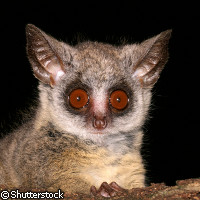Seize the night: mystery of night vision in nocturnal mammals unveiled
Nocturnal animals owe their night vision to a special DNA architecture within the photoreceptor cells of their eyes. This discovery was made by a team of scientists in Germany and the UK and published in the journal Cell. The researchers describe how the rod cell nuclei themselves become tiny light-collecting lenses thanks to their unique DNA packaging. 'Diurnal nuclei are basically scattering obstacles,' explained Dr Jochen Guck of the University of Cambridge in the UK. 'In nocturnal animals, they are little lenses. In one case, light is scattered in all directions and in the other is focused in one direction.' And there are millions of them in every eye. In this way, any residual light is bundled and can travel deeper into the eye, where it can be perceived. In nocturnal mammals, the nuclear structure of the rod cells (photoreceptor cells in the retina of the eye) is inverted by comparison with other non-dividing cells, which show a virtually universal pattern found in single-celled as well as multicellular organisms. Usually, a cell nucleus has so-called heterochromatin on the periphery and euchromatin on the inside. Chromatin is the combination of DNA, RNA, and protein that makes up chromosomes. In heterochromatin DNA is very tightly packed, whereas in euchromatin it is less condensed. Nocturnal mammals have the opposite structure in their eyes: euchromatin on the periphery, heterochromatin on the inside. To shed light on the differences between day and night vision, the researchers studied mice. Mouse rod cells - just like those of other nocturnal mammals - exhibit the inverted nuclear structure. However, they are born with the conventional architecture, which is not transformed until later. As the eyes of nocturnal animals need to be much more light-sensitive, they also show a greater number of rod cells, which in turn increases the thickness of the retinas' outer nuclear layer. Columns of the special nuclei are found there, optimising the transmission of light and channelling it to the light-sensing rod segments. 'The inversion in nocturnal animals makes sure that the light is passed from one nucleus to the next. It is handed down so that it doesn't scatter,' said Dr Guck. Evolutionarily speaking, the conventional rod cell structure is favoured. However, it has been modified on several occasions over time, added Dr Boris Joffe of Ludwig-Maximilians University Munich in Germany. 'Taken together, paleontological, molecular, and morphological data strongly suggest (1) that the inverted pattern appeared very early in the evolution of mammals as an adaptation to nocturnal vision in this primarily nocturnal group of animals,' the study concludes. They also suggest that, 'correspondingly, the conventional pattern was repeatedly reacquired in mammals that readopted a diurnal lifestyle, and that restoration of the conventional architecture most likely demanded selective pressure for the conventional nuclear architecture Comparison of the inverted and conventional patterns can therefore highlight the advantageous features that predetermine the nearly universal prevalence of the conventional nuclear architecture.'
Countries
Germany, United Kingdom



